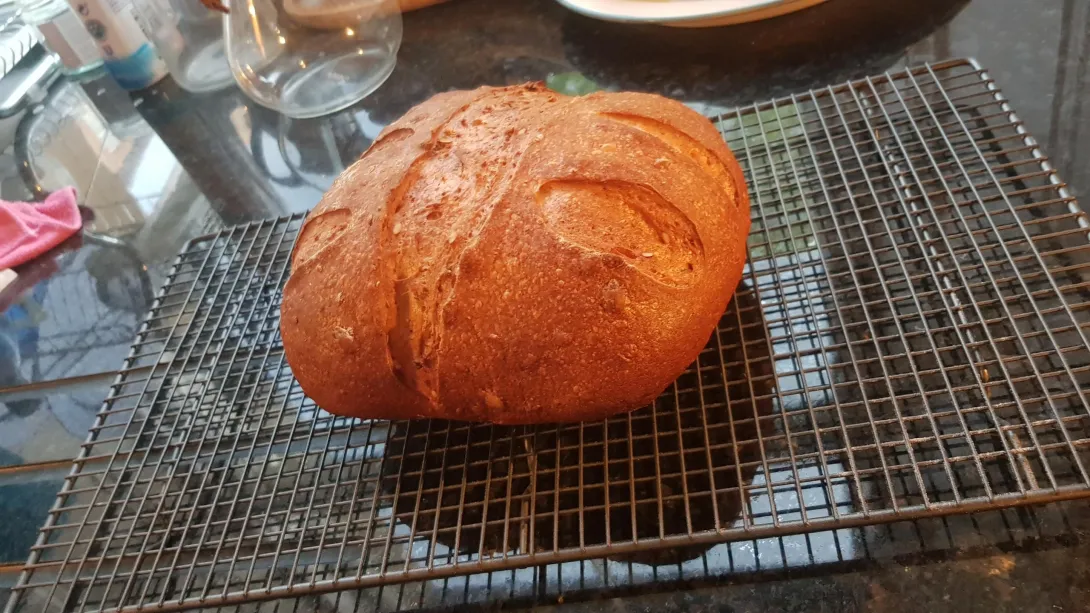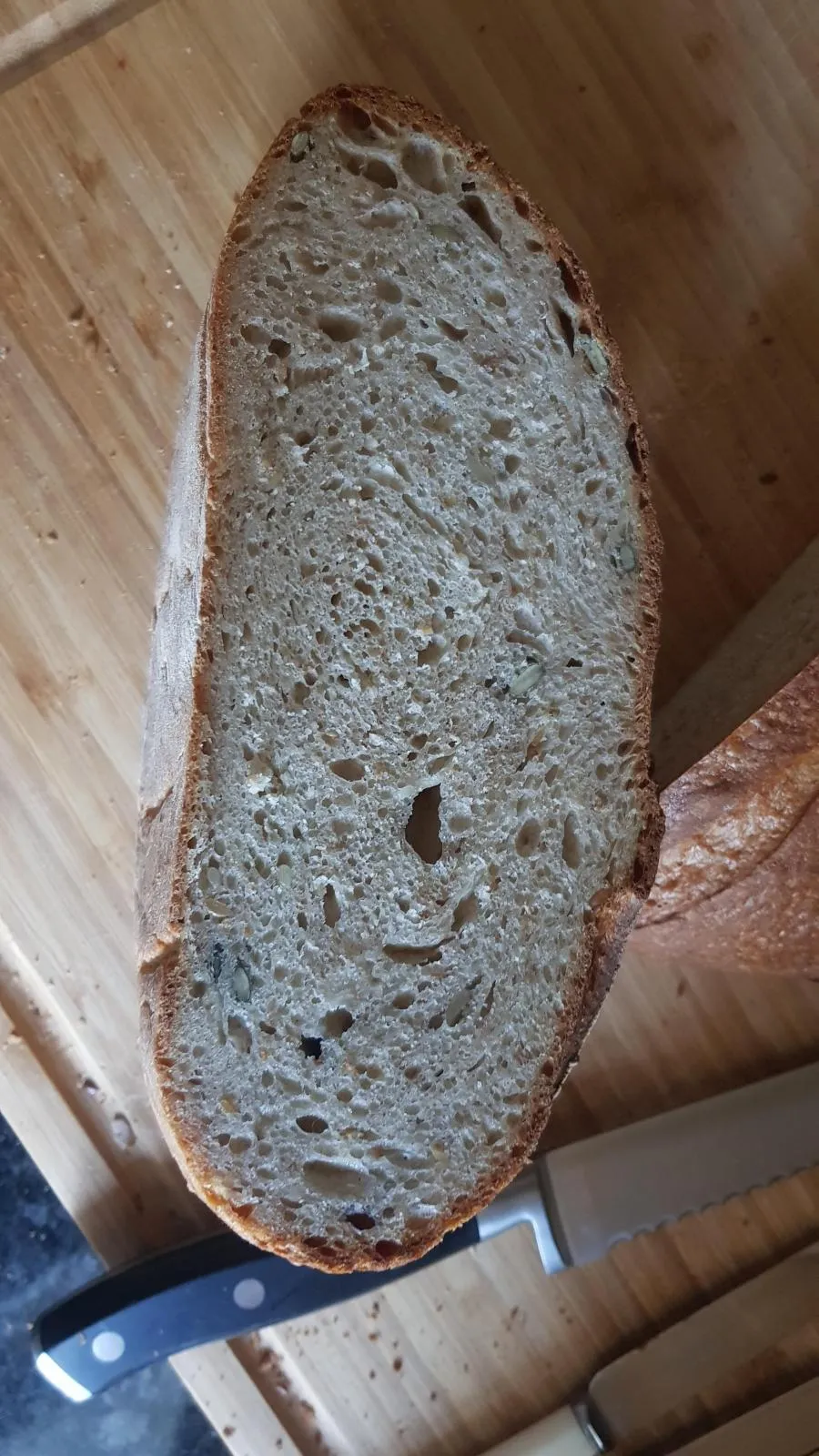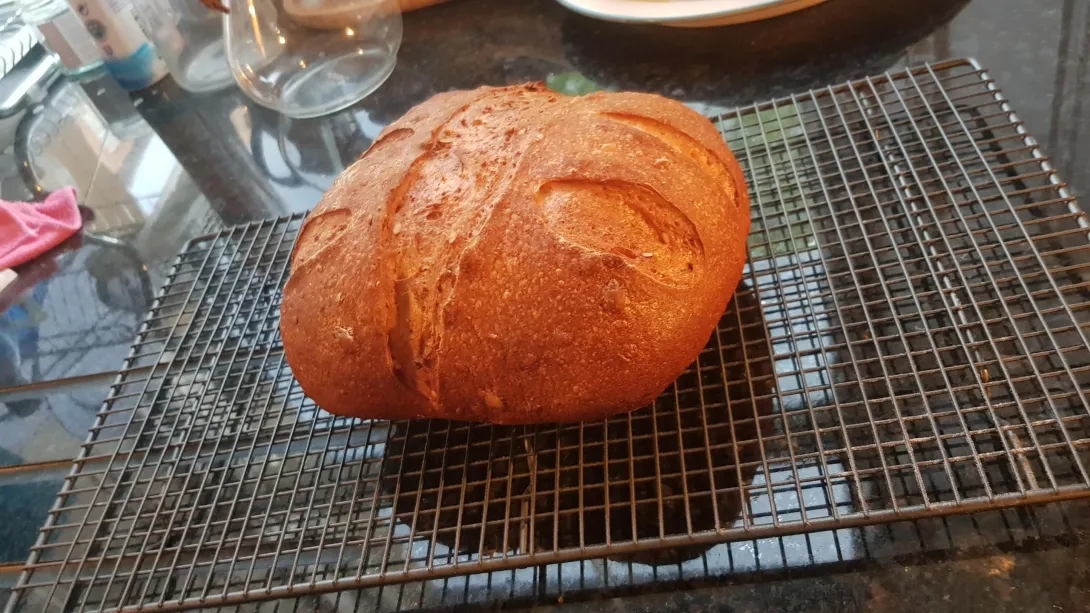
Hi everyone, I am new to sourdough making and am having trouble getting a good texture to my loaf. My loaf seems to come out a little more like "normal" bread than sourdough. The crumb doesn't have nice big holes in it, and is a little crumbly rather than having the string like effect of a sourdough. When i score my dough too, it often pulls the dough, and the final effect doesn't leave the nice stretching strings that other get; rather, it just looks like the rest of the crust. Any thoughts?
Here is my recipe and process -
50g starter mixed with 25g white/25g wholemeal and 50ml water. I leave this over night to make the levain.
Next day i add 300g strong white, 200g wholemeal, 15g vital wheat gluten and 300g water. I mix this together and leave for 1 hour at room temp. I then add 2 teaspoons of salt, 1 tablespoon of oil, and 30g water. I work this into the dough until it is smooth. I then cover it and leave for another hour. Following this i perform stretch and folds on the hour every hour for 8 hours. I then shape it and put it in the fridge overnight. The next morning i take it out the fridge, and give it a gentle reshape. I then score it, roughly 1cm deep. It goes in the oven at 250c for 20 mins, then lowered to 200 for 30 mins. Ive tried both dutch oven and on a baking sheet.
Every small change i make doesn't seem to make a big difference to my end product. Any advice would be appreciated.


I think I am onto something because I am well read and quite experienced, although not in the specific ways some others on this site are.
A few things stick out to me as contributing factors. No. 1 is the gentle reshape in the morning. Don’t do it. This is a degassing of the dough.
Secondly, fats in a dough (oil in your case) tend to inhibit the crumb you are asking for, and promote a more even crumb structure (ie a white bread sandwich loaf, or a cake, for extreme examples).
Thirdly, your dough has 67% hydration by my count. Though it can be done (refer to Trevor Wilson’s videos), the crumb you seek is more difficult to achieve under 70% hydration.
Fourthly, if you are mixing your dough until smooth, do you mean full gluten development? This is the windowpane stage where you can stretch a bit of dough (taking your time) into a very thin, see through pane (like a window). Or at least medium development (where it tears before windowpaning). In either case, so many stretch and folds would be unnecessary for gluten development and would promote more uniform cell structure because of the degassing nature of stretch and folds.
Finally, I think your crumb looks great for a true sourdough. If you like the taste and texture, keep it that way. Feel free to experiment.
At this point I think a good introduction for the crumb you seek is the country loaf from Tartine Bread:
100 whole wheat
900 bread flour
700 water
100 starter
20 salt.
Desired dough temp is about 75 F with ambient room temp about the same (72ish). Recommended bulk ferment of 4 hours on average. Overnight cold proof in refrigerator.
This is really helpful, thank you.
Can i just ask what the difference will be in the final bake between the full gluten development vs only partial? To get the open crumb texture do i want more or less development?
Full gluten development will give you a tighter, more even crumb. Less development will give you bigger bubbles and a more uneven crumb. Sourdoughs reach sufficient gluten development to make good bread by proofing for a long time. Two ways to reach full development are through more mixing or more time. Doing both is unnecessary and likely counterproductive. A longer initial mix results in a shorter bulk fermentation time, sometimes by up to 30% shorter for a sourdough.
Here is why this matters: if the gluten network is strong, imagine how much more effort the yeast has to work to blow bubbles bigger. Think of blowing a balloon and how much harder it is to inflate if the rubber is tight.
So helpful, thank you.
I get really confused about gluten development. So, we want good development or else the bread wont rise good, right? But if its too well developed, the crumb will be very closed and it will be dense, is that right? I'm confused on what we really want because if the gluten network is strong we wont get satisfactory results, but we try to aim for strong development to get any open crumb at all, dont we? Or is sourdough different and we only want partial development? Man, I'm so lost, haha!
Oil, whole wheat, and do I see seeds (?) - none of them promote open crumb. I agree with previous comment on shaping, but it's very possible that this is just what this formula is capable of giving.
This is great thanks. Yes i forgot to mention i had put seeds in. Have you got any tips on what does promote open crumb?
Here's a couple thoughts, based upon my experiences baking: I don't think you need to add any vital wheat gluten when you are using 50% WW in your levain and 40% WW in your dough. The only time you should need to add any vital wheat gluten is when you are using a low protein flour and want to boost the gluten amount. Vital wheat gluten, when not needed, can make a crumbly textured dough. Also, if your WW flour isn't sifted (still has all the bran), you will probably have a hard time getting airy holes in the interior of your loaves as the bran cuts the gluten strands. It looks like the total water amount is a little on the low side for the amount of flour you are using. And, doing stretch and folds over an 8-hour period seems like a long time to me--I usually only have to do this for about 3-4 hours max. Finally, once you have shaped your loaves and popped them in the fridge overnight, they should be good to go in the morning, straight into the oven...no need for reshaping again. Hope that helps!
That is really interesting concerning the vital wheat gluten. My understanding of how the gluten works is very poor. I sort of assumed the stronger my gluten the better gluten strands i would get, leading to the sort of crumb i was looking for rather than the crumbly texture i am getting. I will look to sift out the bran too and see what difference that makes. Thanks.
I think you will find a variety of thoughts on vital wheat gluten on this site. Some believe it will help raise a loaf when using whole wheat flours, but I have not found that to be the case, at least with my bakes, and I know I have read other comments from people thinking it isn't a necessary addition. But, I am only using a portion of WW flour in most of my recipes, and most of that has been sifted or ground very fine. So long as you have a good portion of higher protein flour (strong flour/bread flour/etc) in addition to the whole wheat flour, you shouldn't need the addition of the vital wheat gluten. I have had the best success with no more than 20-25% maximum of whole wheat flour and the rest strong bread flour. I will use a lower percentage of WW when I am using my whole wheat starter, but can tick that up a bit higher if I am using my AP starter.
I have read some threads here too, where the bran is sifted out, soaked and then added back in later, which reportedly helps with rise. That way, the health benefits of the bran are maintained. I am planning on trying this in the not-too-distant future as I would love to boost the nutrition in my bakes.
Gluten structure is also improved by the S&Fs after a decent autolyse--everything I'm reading now indicates plenty of gluten can be built during these phases without the need for direct kneading. When I do S&Fs, I'm fairly assertive with how far I pull the dough up while being careful not to tear it. I've attempted the Ribaud method, but just don't have the hang of that, so I prefer the autolyse/S&F methods. But, everyone has to find what works best for them, with their ingredients, in their kitchens. I hope you'll post again with your results...we are all learning here!
That is so helpful, thank you.
You've had some good replies, but I would also add that your levain build doesn't seem quite right. your overnight build is 1:1:1 starter:flour:water. We don't know your temperature, but normally I would expect an overnight build to have a higher starter:flour ratio. I would probably go 1:3 or 1:4 at 23-24C. Your levain may be past it's peak.
Check out Kristen's starter maintenance on Youtube.
Lance
Ah that is interesting. So for a 500g flour loaf, what would you recommend for a levain? Something like 25g starter, 100g flour, 100ml water? My overnight temperature is around 18c...
Select start amount based on how long you wish to ferment. Deduct from total flour and water accordingly. 18 degrees seems quite cool. Stir in a little more flour in the morning, seal it and leave it somewhere warm an hour before you use it. Thatll really get it going.
You probably only want something like 125g levain for 500g flour. I'd do something like 20:80:80 and discard the rest. But, and it's a big but, that will only work if you can get your temp up round 25C. At 18C your starter will be much more sluggish and also unbalanced in terms of bacteria and yeast ratios.
So see if you can create a warm spot. At its simplest, a cool bag or box with the lev and a couple of old water bottles filled with warm water might do the trick.
Lance